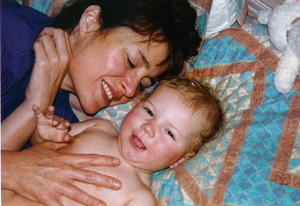|
||
      |
Peer Review ::
Open Mike
Child-advocacy worker Theresa Reid, PhD’01, confronts the realities (and red tape) of adoption.

Theresa Reid with daughter Natalie (13 months old) upon return from Russia.
Theresa Reid was never passionate about having kids—until, in her late 30s, she found out she couldn’t. After three frustrating attempts at in vitro fertilization, she and her husband Mark began the “adoption journey,” an emotionally, financially, and physically taxing ordeal chronicled in Two Little Girls: A Memoir of Adoption (Berkley Books, 2006). Leery of the U.S. foster-care system and desperate to avoid “nightmare cases” like those of Baby Jessica and Baby Richard, in which children were taken from their adopted homes after birth parents demanded them back, the couple decided to adopt overseas. Braving a maze of paperwork, social-worker visits, and false starts, they traveled to an orphanage in Ekaterinberg, Russia, to adopt 11-month old Natalie (now 9) in 1997. Little sister Lana (now 6), born in Kiev, joined the family in 2002. In her book, Reid discusses America’s biological bias, psychological barriers to adoption, and the perfect child.
Loving your child: People think it’s hard to love kids who aren’t born to them. But love is a mystery. Somehow when a child is born to you, you just think that love is going to be automatic. Actually, it isn’t. But in people’s imaginations, it’s a lot easier to bond with a child who is born to you. Another way of saying it is that people imagine that biology is necessary to love. But it’s neither necessary nor sufficient.
Biggest adoption myth: In the standard adoption memoir, the only obstacles are external. There’s the love object (the child) and the lovers (the parents), and all of these external obstacles prevent their coming together. Very few acknowledge the internal obstacles: the fact that you don’t fall in love at first sight, the fact that you’re not sure you’re going to love this child, the fact that you might be terrified.
The Angelina Jolie factor: What she’s doing is great—she doesn’t consider biology a prerequisite to love. But it’s the image of her swooping down out of the skies, cool, magnanimous, unruffled, already in love. All of the angst is gone. What disturbs me about it is the reinforcement of the myth of the heroic and selfless adopter. But we’re neither heroic nor selfless—we’re usually scared and pretty selfish actually.
Finding the right child: Everybody wants a perfect child. Who doesn’t? But for bio parents, the desire for a perfect baby begins in nurturing, loving actions—eating right, exercising, avoiding alcohol. For adoptive parents, it begins in rejection. We are confronted with lists of possible problems—things like “born of rape,” “born of incest,” “club foot,” “harelip,” “mother used alcohol,” “mother used drugs,” etc—and asked to check “Yes,” “No”, or “Will Consider.” This is a wrenching process of rejection in the search for a perfect child.
The cultural bias: We are absolutely marinated in messages about the tragedy of infertility—how awful, oh my God, the grief, the nightmare. If you don’t feel those things, there must be something wrong with you. People say, “Why aren’t you sad? You have to want to reproduce.” What if we were all marinated in messages that biology matters a great deal to some people and not so much to others? I think more people would know that they could love somebody else’s child and would be freed to adopt.